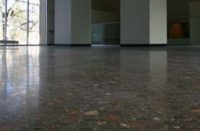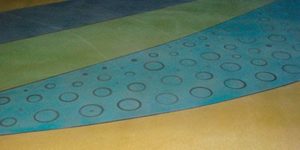
School flooring has long been the domain of carpet and vinyl.
That’s changing. Officials who run elementary and secondary schools (and even colleges) are becoming aware of concrete flooring as an option. And concrete flooring professionals have begun to notice schools as a market. That said, decorative concrete is better suited for some areas of a school than others, an important fact to keep in mind when bidding and designing projects.
Areas where concrete works
Concrete flooring is ideal for most areas in schools, with a few exceptions and considerations. That’s according to Prosoco representative Ron Saunders, who estimates he’s worked on or consulted on more than 60 schools during his 20-plus years in construction.
Concrete flooring, with its durability, aesthetic potential and low maintenance requirement, is ideal for classrooms, restrooms, offices, and common areas like lobbies, auditoriums and hallways. A consideration — some might say drawback — is that areas with hard flooring can be noisy. Saunders calls noise ricocheting off hard surfaces “sound-slap.” He notes that auditoriums usually have sound-deadening panels on the walls.
Carpet can quiet noisy classrooms — it just goes on the walls, not the floors, Saunders says. Carpet takes much less of a beating and lasts longer on walls than on floors. Concrete is meant to take a beating, so the classroom floor is a good place for it.
Washable rugs, mats and cushions can replace the seating comfort carpet provides children in classrooms while maintaining the considerable advantages of concrete flooring. Rubber antifatigue mats can make standing on concrete floors comfortable for cafeteria workers.
The Asthma Regional Council of New England names concrete flooring as a top choice over carpet and vinyl for schools. In the group’s 2005 white paper “Health Considerations When Choosing School Flooring,” author and certified industrial hygienist Frances Gilmore, M.S., writes: “A number of pollutants that are associated with respiratory illnesses, including dusts, mold and mildew, are captured and can grow in carpets and then get released into the air. Vinyl is also subject to mold and mildew when water pools below it. Vinyl is also the most toxic flooring material to manufacture and to dispose of.”
Gilmore gives concrete floors high marks for lower maintenance, higher durability, being better for health and having less environmental impact than carpet and vinyl.
Vocational “shop” classrooms are good choices for concrete floors, says architect Mark Muller, of Treanor Architects, Lawrence, Kan. And concrete floors are always appropriate for janitorial, electrical and other utility spaces — anywhere there could be wheeled traffic or other heavy use. All these floors, at a minimum, require dustproofing with a hardener/ densifier or film-forming sealer.
Areas of concern for concrete floors
While concrete is OK for outdoor basketball courts, Saunders says wood is the best choice for indoor courts — but only because it’s traditional.
Kitchens are too spill-prone to make concrete a good floor choice there, he says. Concrete is porous and soaks up all the stuff that gets spilled on it. Juices, vinegars and even milk can etch the concrete. Water repellents and oil repellents can afford some protection, but an impermeable surface like glazed clay tile is a better choice, he says. Even then, the grout needs a protective treatment.
Muller suggests caution when planning concrete floors in school labs where students might handle acids or reagents. Concrete floors in art rooms where dyes and paints could be spilled also merit extra consideration.

Benefits and expectations
Officials in cash-strapped schools will weigh the cost of grinding and other surface prep against simply putting down resilient flooring, Muller says. But eliminating waxing, buffing and stripping can save schools quite a bit of money over the course of a year, a decade or a bond issue.
That’s a crucial step in making concrete floors attractive to school decision-makers, Muller says, many of whom are much more familiar and comfortable with traditional carpet and vinyl flooring choices.
“Be sure to educate the maintenance staff on that point, too,” he added. “Some maintenance technicians are of the opinion that if it’s horizontal and doesn’t have carpet, it should be waxed and buffed no matter what.”
Making sure the concrete floor meets client expectations is important for getting additional work, says David Stephenson, co-owner of American Concrete Concepts Inc., Springdale, Ark. The best way to do that is to manage the client’s expectations from the start.
“I had a school district superintendent who was paying under $5 a square foot, but who wanted a perfect $22-to-$23-per-square-foot terrazzo finish,” Stephenson says. “Instead of telling him right away I could do it, I had the general contractor pour a 20- square-foot sample to the same specs as the 80,000-square-foot slab that was planned.”
Stephenson and his crew then ground and polished the sample for the superintendent. Though it wasn’t a terrazzo finish, it looked good, Stephenson says.
“We went after it aggressively and exposed a lot of black, white and gray aggregate. The superintendent was extremely satisfied once he understood the process and knew what to expect.”
No matter how good the job looked, Stephenson says, he probably would have been in trouble if he hadn’t managed expectations by creating the sample. That’s because you can’t match the image in the client’s head unless it’s an image you put there yourself.

Environmental concerns
Polished concrete floors have green benefits, some of which are better known than others. Here’s one: New concrete is usually produced locally, so a client will avoid the energy consumption required for lengthy transport of heavy rolls of carpet and boxes of tile, Muller points out.
Old concrete subfloors, stripped of worn carpet or failing vinyl, are already there. They don’t even demand the limited transport cost of a concrete truck.
Since concrete floors don’t need to be replaced, they don’t take up space in landfills like other flooring types that have to be removed at the end of their service lives or because of accidents — floods or spills, for example. While many flooring manufacturers offer recycling options for their products, concrete stays serviceable for the life of the building.
All these factors, from durability and low maintenance to health and environmental concerns, make concrete increasingly attractive to school officials in markets large and small.
And that makes schools one more viable market for concrete flooring professionals.
The Asthma Regional Council’s white paper “Health Considerations When Choosing School Flooring,” by Frances Gilmore, is available online: asthmaregionalcouncil.org/uploads/IAQ/HealthConsiderationswhenChoosingSchoolFlooring.pdf















